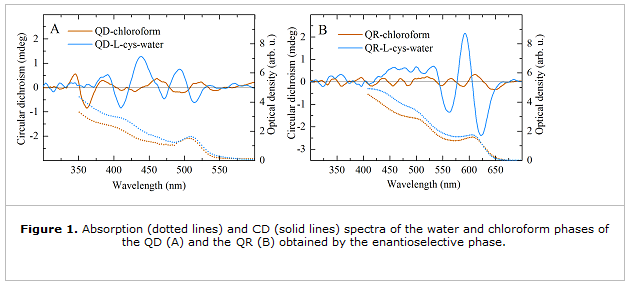Saint-Petersburg National Research University of Information Technologies, Mechanics and Optics, St. Petersburg, Russia
Trinity College Dublin, Dublin, Ireland
«Poster report»
OF THE REPORT:
Maria V. Mukhina, Vladimir G. Maslov, Alexander V. Baranov, Anatoly V. Fedorov, Yurii K. Gun’ko
Maria Mukhina
INVESTIGATION OF INHERENT CHIRALITY OF CdSe/ZnS NANOCRYSTALS
We investigate inherent chirality of semiconductor nanocrystals. Under assumption that as-prepared ensemble is a mixture of achiral nanocrystals and equal amounts of nanocrystals with opposite chirality, we develop the method of enantioselective phase transfer, which allows partial resolution of the enantiomers by using of a chiral ligand (cysteine). At sufficiently low concentration of cysteine, it is possible to achieve equal concentration of the nanocrystals in water and chloroform. The water phase displays optical activity of the nanocrystals modified by attachment of the chiral ligands. The chloroform phase also shows optical activity. We assume that the nanocrystals in the chloroform phase possess inherent chirality, because in this case their surfaces are not modified by chiral ligands.
Chirality is a fundamental property of multitude of objects in the physical world. This phenomenon has attracted considerable attention in many scientific disciplines, such as organic chemistry, biology, astronomy, and particle physics. In particular, the discovery of stereospecific molecular recognition and the methods of enantioselective synthesis have played a crucial role, because of dramatic difference in an efficiency of chiral medications compared with racemic ones.
Semiconductor nanocrystals (Quantum Dots (QD), Quantum Rods (QR), quantum nanoplatelets etc.) are also under active investigation. Tunable optical properties and high photostability combined withgreat potential for surface modification and functionalization make it possible to use such nanocrystals as luminescent labels and sensors in biology, in photodynamic therapy of cancer, in photovoltaics, and many other applications of nanophotonics. However, little attention has been paid to chirality of these objects. There were some papers on chirality induced by adsorption of the chiral ligands on the surface of nanocrystals. Different explanations of QD induced chirality appearance have been given in these works, but none of these explanations considered that chirality might be an inherent property of the semiconductor nanocrystals due to their crystal lattice structure. In the contrast, inherent chirality of carbon and metal nanostructures has got a detailed description. Nevertheless, assumption of inherent chirality of the semiconductor nanocrystals can have a tremendouseffect on the nanotechnology field. Because the key advantage of using artificial nanocrystals is an ability to manipulate the units of matter at the scale close to molecular one. If nanocrystal, whose sizes are comparable to the sizes of biomolecules and the pores of cell membranes, also possesses chirality, its «lock and key» interaction with biological objects may be possible.
Here, we investigate inherent chirality of CdSe/ZnS nanocrystals using a technique of circular dichroism (CD). CD activity indicates a chiral structure. We develop an experiment under assumption that as-prepared ensemble is a mixture of achiral nanocrystals and equal amounts of nanocrystals with opposite chirality. Consequently, to obtain an experimental evidence of inherent chirality of the semiconductor nanocrystals, it is necessary to separate their enantiomers. We show that optically active the QD and QR samples can be obtained by preferentially extracting either right- (D-) or left-(L-)handed nanocrystals from optically inactive sample. We use an original method of the enantioselective phase transfer of the nanocrystals from chloroform to water assisted by the chiral molecules of cysteine. We assume that the enantiomers of cysteine preferentially bind to nanocrystals enantiomers with the same chirality.
CdSe/ZnS core-shell QR (35 nm in length and 5 nm in diameter) and QD (2.5 nm in diameter) possess a photoluminescence band centered around 630 and 520 nm, respectively. As-prepared nanocrystals were surface capped by achiral ligands, trioctylphosphine oxide (TOPO). To obtain optical enrichment, the samples were dissolved in chloroform. The solutions were cooled to slow the enantioselective phase transfer. Then 5 vol. % of concentrated methanol solution of D- or L-cysteine was added to the nanocrystals solution followed by stirring. Next distilled water was added to chloroform. To initiate the phase transfer, the mixture was vigorously shaken and left for 1-2 minutes. After complete separation of the chloroform phase and the water phase, optically enriched fraction of the nanocrystals capped by cysteine was transferred to water. In the contrast, the chloroform phase contained the nanocrystals still capped by TOPO. Next, the chloroform phase was stabilized by increasing the pH to 10-11. CD and absorption spectra were measured using a Jasco J-1500 spectrometer.

CD spectra measured for the QD and QR after the enantioselective phase transfer assisted by L-cysteine are shown in Figure 1. The same set of experimental data was also obtained with D-cysteine. Two types of chiral enriched solutions of nanocrystals were obtained as a result of the phase transfer. The fraction of nanocrystals in water is enriched with nanocrystals with the same chirality as the ligand molecules used for the phase transfer, for example, L-nanocrystals in the case of using L-cysteine. In the contrast, the chloroform phase is enriched with the nanocrystals, whose interaction with chiral ligands was ineffective. These nanocrystals are still capped by achiral ligands. We assume that the reason for low efficiency of the interaction between the nanocrystals and chiral ligands is their opposite chirality. As shown in Figure 1, the water and chloroform fractions possess almost mirror image CD signals, but the value of inherent CD signal in chloroform is less. The reason for this difference may be an induced increasing of CD after adsorption of chiral ligands.
In conclusion, we have developed the method of chiral resolution ofananocrystalsensemble. Using this method, we have shown that chirality is an intrinsic property of semiconductor nanocrystals.